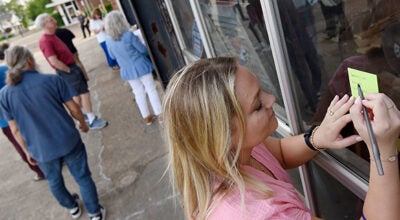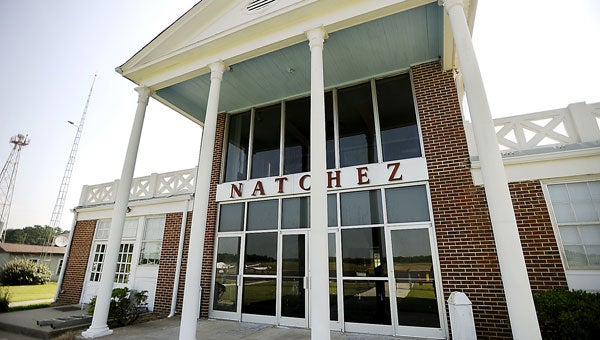Local Coast Guard crew masters of the Mississippi
Published 12:40 am Sunday, July 24, 2011

ERIC SHELTON | THE NATCHEZ DEMOCRAT Fireman Jacob Everton, right, Petty Officer Paul Haddock, center, and Petty Officer Edward Stommel work on the engine of the USCGC Greenbrier.
NATCHEZ — The most famous boat in Natchez may clamor with the sound of slot machines and tease tastebuds with the smell of a seafood buffet, but the most important boat in town, equipped with a personal chef and only a few decks of cards, tells a different story entirely.
The 16-person crew of the United States Coast Guard Cutter Greenbrier, located at the Coast Guard Station off River Terminal Road in Natchez, makes sure river traffic continues to run smoothly.

The USCGC Greenbrier is in port at the Natchez Coast Guard station or on the Mississippi River every other week.
The crew works from early in the morning until dark, and Master Chief Randy Merrick, officer in charge, said life on the boat takes on a family dynamic.
“It’s like a family for the simple fact that you’re moving to a place where you don’t know anybody,” Merrick said. “Your ship mates are your extended family.”
Merrick said the crew plays cards and watches movies in downtime when they aren’t hard at work making the Mississippi River safe for traffic.
“It’s such a small crew, if we didn’t socialize, it’d be awful boring,” Merrick said. “We also eat very well. We have a new cook, a graduate of the Culinary Institute of America.
“We are very fortunate with the people we have on this boat. It makes the job a lot better.”
The crew is responsible for the Mississippi River from the Miss-Lou bridge, mile 363, to mile 155, about halfway between New Orleans and Baton Rogue. The Greenbrier also covers the first 40 miles of the Atchafalaya River and Red River.
The station’s sector is called the lower Mississippi River, part of the eighth Coast Guard district. While most Coast Guard vessels are located at sea, Merrick said 16 boats work the rivers, the Greenbrier being the furthest south.

Seaman Thomas Delcambre, left, Seaman Brandon Andrae, center, and Seaman Andy Dibsbury inspect their life vest Thursday afternoon at the Coast Guard Station.
Merrick said the Coast Guard’s station doesn’t have any Natchez natives.
“The closest is from New Iberia, La.,” Merrick said. “We have guys from places like Illinois and Montana. The biggest acclimation for some of them from the North is getting used to the heat.”
Merrick, who has been in the Coast Guard for 26 years, said as master chief, he serves four-year tours and crewmembers serve three-year tours, which can be hard on any family.
“It takes a very special spouse to do this for 26 years,” Merrick said. “They have to be supportive, patient — take all those little adjectives and that’s what a Coast Guard spouse is.”
When in port, single, junior personnel stay in the barracks at the station. Married crewmembers live with their spouses in the Natchez area.
Merrick said crewmembers are in port or under way (on the river) every other week. Thirteen people go under way with the boat, and three always stay behind at the station.
On days in port, Merrick said administrative matters are handled, the crew undergoes training and maintenance issues are addressed.

Master Chief Randy Merrick calls to the crew working on the deck via intercom from the control room.
“A typical day under way — I make decisions on the depth of the water, and if I will put more buoys in,” Merrick said.
The crew’s main duty, Merrick said, is to keep river traffic moving.
Merrick said on the coast, buoys have assigned positions.
“Ours, we move around based on what the river does,” Merrick said. “What we do is mark the channel for tow boats. When the water recedes or rises, buoys have to be arranged to show where it is safe for barges to pass so they don’t run aground. We also set up shore aids.”
Shore aids are structures that also assist river traffic with navigation.
Merrick said the Coast Guard stations on the country’s coastlines handle more search and rescue and law enforcement operations — which is what drew him to the guard.
“I like saving babies and busting druggies,” Merrick said. “That’s why I got into it 26 years ago — for search and rescue and law enforcement. That was always my favorite, but now, it’s definitely aids and navigation.”
Seaman Brandon Andrae of Savannah, Ga., said the crew must guarantee at least 14 feet of water depth where
they mark the buoys as safe water for barges.
“(Barges) will not run aground if the buoys are marked,” Andrae said. “The tops of the buoys are radar reflectors so they can be picked up on radar as well as reflective tape that makes them pop out.”
Andrae said the crew must be mindful of hazards at all times.
“If you’re replacing a buoy, and the line attached pulls and gets taunt, it can snap, whip up and possibly hit someone,” Andrae said.
The master chief said operations usually run smoothly with exception of weather.
“Out on the river, storms seem to come up out of nowhere,” Merrick said. “You’ve got 40 mile-per-hour winds, it’s raining sideways and you worry about the boat and crew. It can get a little on the hairy side at times.”
The Natchez Coast Guard station on land has survived the elements as well — most recently the 2011 Mississippi River Flood. Floodwaters completely surrounded the facility, but with help, the crew was able to keep the water out of the station for the most part.
“The rough estimate is that we saved a half million dollars by keeping the water out,” Merrick said. “The air conditioning units were all saved and electrical things didn’t have to be replaced. We didn’t have to tear out any duct work.”
About an inch of water did seep into the facility, which was continually pumped right back out. Water-damaged sheetrock has been removed four feet from the floor in the station to be replaced.
“Contractors are coming in to remove debris and renovate the building next week,” Merrick said.
The county and city assisted the station by providing sandbags, pumps and more during the flood.
“We are eternally grateful to the county and city entities whole helped us during the flood, because honestly, we wouldn’t have made it,” Merrick said. “The supplies sent from the port authority were a godsend. We wouldn’t have kept the water out of the building — simple as that.”
Merrick pointed to nine mangled shore aids on the barge, or deck, of the Greenbrier.
“They were destroyed and we had to rebuild them,” Merrick said.
Rebuilding shore aids seems like a daunting task, but the crew is young and strong enough to handle the job.
Merrick said new Coast Guard recruits have typically been ages 18 to 21, but that has changed lately.
“The age range is getting a little older, the last two were college grads, which I think has to do with the economy and lack of jobs,” Merrick said. “But I do have devices on my uniform that are older than some of these kids.”
Merrick said he would encourage anyone who is considering a career in the Coast Guard to go for it. He said that unlike a lot of jobs, at the end of the day he can scan the river and see what the crew accomplished.
“It’s very rewarding,” Merrick said. “The beauty of aids and navigation is that at the end of every workday under way, you can look over your shoulder and see what you did that day.”






